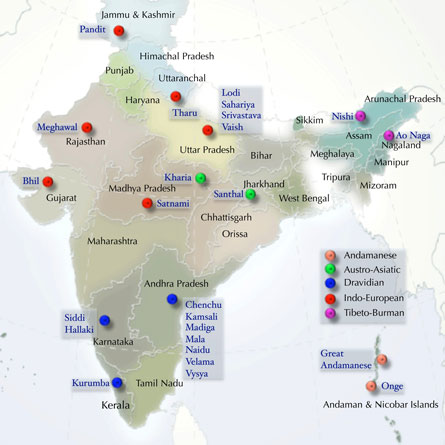DNA points to India’s two-pronged ancestry
Diverse groups in the South Asian nation may derive from a pair of ancient populations
India’s 1.2 billion people belong to more than 4,600 ethnic and religious groups separated by caste, customs and language. But a shared genetic heritage runs deep in this teeming nation, a new DNA analysis suggests.

Indians today possess varying proportions of ancestry from two genetically distinct populations, concludes a team led by David Reich, a geneticist at Harvard Medical School in Boston. Members of one ancient population share DNA patterns with modern Middle Easterners, central Asians and Europeans, the researchers report in the Sept. 24 Nature. The other population shows no strong connection to any modern mainland group. The first group is dubbed “Ancestral North Indians” and the second “Ancestral South Indians.” Both of the groups existed before the founding populations that contributed to today’s genetic diversity moved to South Asia.
Members of each modern Indian group have inherited between 40 and 80 percent of their DNA from Ancestral North Indians and the rest from Ancestral South Indians, Reich and his colleagues say. This pattern applied to all castes within India and to traditional tribes as well. Each of these groups was derived from separate founding populations, according to the analysis. These founding populations arrived in South Asia between about 200 and 2,500 years ago, well before the colonial era, suggesting that current caste and ethnic divisions predate that time.
“This supports the view that castes grew directly out of tribal-like organizations during the formation of Indian society,” says molecular biologist and study coauthor Kumarasamy Thangaraj of the Center for Cellular and Molecular Biology in Hyderabad, India.
Members of upper castes and speakers of Indo-European languages, including Hindi, possessed the most genetic traits attributed to Ancestral North Indians.
A shared genetic ancestry from two ancient populations “may be the strong, invisible thread that binds all Indians” despite barriers of caste and custom, writes geneticist Aravinda Chakravarti of Johns Hopkins School of Medicine in Baltimore in a comment appearing in the same issue of Nature.
Reich’s team examined alterations of more than 560,000 nucleotides—the basic constituents of DNA—across the genome. DNA samples came from 132 individuals who belong to 25 groups representative of India’s ethnic and linguistic diversity. The researchers plugged this information into a new statistical model that they developed to reconstruct India’s genetic roots.
Many groups in India share an unusually large number of DNA alterations at precise spots. These findings fit a scenario in which many Indian populations were founded by small numbers of people that married and reproduced within their own groups, Reich’s team proposes. Marriage with outsiders would have diluted the number of shared DNA variations.
Other populations that have grown in relative isolation, such as Finns and Ashkenazi Jews, display many recessive genetic diseases. Further studies in India may identify genes involved in such diseases, the investigators say.
In one exception to the pattern of genetic mixture in Indian groups, Onge hunter-gatherers living on the Andaman Islands in the Indian Ocean display purely Ancestral South Indian ancestry, Reich and his colleagues say. Andaman Islanders possess direct genetic links to modern humans that left Africa around 70,000 years ago and eventually colonized what is now India, they suggest.
According to earlier research, India’s initial settlers arrived around 60,000 years ago. Speakers of Dravidian languages arrived roughly 5,000 years ago, followed by Indo-European speakers approximately 3,500 years ago. If the new analysis holds up, these early populations wouldn’t have contributed to modern mainland India’s genetic makeup. And founding populations of today’s Indian groups wouldn’t have reached South Asia until well after Indo-European speakers.
The team’s model can’t yet determine the original genetic makeup of India’s two ancestral populations or estimate when the two ancestral populations originated and first mixed. But the new analysis better dissects genetic relationships among groups in India than a 2008 study that analyzed variation at 405 nucleotides in 55 groups, Thangaraj says.






